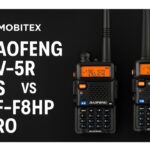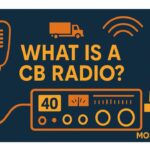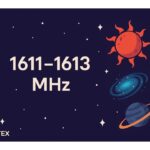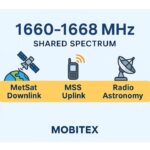The 1611–1613 MHz band may appear narrow, but it’s one of the most technically significant segments in the upper L-band spectrum. It forms a unique intersection between mobile satellite uplinks and radio astronomy, requiring careful international coordination to balance communications and scientific observation.
This band sits just above the Global Navigation Satellite System (GNSS) frequencies (up to 1610 MHz) and below the main mobile satellite service (MSS) uplink range (1610–1626.5 MHz). Because of this, it serves as both a transition zone and a protected observation window.
🌍 Band Overview
| Parameter | Details |
|---|---|
| Frequency Range | 1611–1613 MHz |
| ITU Allocation | Shared: Radio Astronomy / Mobile Satellite Service (MSS) |
| Band Type | Upper L-band |
| Wavelength | ~18.6 cm |
| ITU Regions | Allocated globally (Regions 1, 2, 3) with national coordination requirements |

🛰️ Primary Uses
1. Mobile Satellite Service (MSS) Uplink
This frequency range overlaps slightly with the lower edge of the MSS uplink band (1610–1626.5 MHz), used by:
- Iridium, Globalstar, and Ligado/SkyTerra satellite systems
- Handheld and vehicular satellite phones
- Maritime and aviation satellite terminals
- IoT and low-rate data uplinks
These services rely on uplink transmissions from Earth to satellite, typically using TDMA or FDMA waveforms with narrow channels (31.25 kHz or similar).
At 1611 MHz, these signals are at the beginning of the satellite uplink allocation, so transmission power and frequency stability are carefully controlled to avoid interference with adjacent scientific services.
2. Radio Astronomy – Hydroxyl (OH) Line Observations
The 1611–1613 MHz range includes one of the hydroxyl (OH) spectral line frequencies (1612.231 MHz), which is vital for astronomical research.
The 1612 MHz OH line is emitted by molecules in:
- Expanding envelopes of late-type stars (like red giants)
- Interstellar molecular clouds
- Maser sources in regions of star formation
These signals are incredibly weak — often billions of times fainter than man-made emissions — so the ITU protects this band under Radio Astronomy Service (RAS) designations.
Radio observatories such as the Green Bank Telescope (USA), Effelsberg (Germany), and Parkes (Australia) use this range to study:
- Stellar evolution and mass loss
- Interstellar chemistry
- Maser amplification mechanisms
3. Transition and Guard Band Function
Because the GNSS downlinks end at 1610 MHz and the MSS uplinks begin immediately after, the 1611–1613 MHz segment serves as a guard band between navigation and satellite communication services.
This buffer minimizes interference between:
- Weak satellite navigation signals (1559–1610 MHz)
- Stronger uplink transmissions from MSS ground terminals (1610–1626.5 MHz)
In some countries, 1611–1613 MHz is treated as a “quiet zone” — limiting commercial satellite uplinks and reserving use for passive or coordinated scientific observation.
⚙️ Technical and Regulatory Details
| Aspect | Details |
|---|---|
| Propagation | Excellent for long-distance and satellite communication |
| Polarization | Circular (for MSS) or Linear (for RAS) |
| Channel Bandwidths | MSS: 31.25–41.67 kHz; RAS: <10 kHz narrowband |
| Coordination Requirements | ITU Radio Regulations 5.379 and 5.379A |
| Protection Criteria | RAS observations must be protected from interference exceeding –255 dBW/m²/Hz |
🌎 Regional Allocations
| Region | Primary Allocation | Notes |
|---|---|---|
| Region 1 (Europe, Africa) | Radio Astronomy (primary), MSS (secondary) | Strict protection zones for observatories |
| Region 2 (Americas) | MSS uplink (primary), RAS (co-primary) | Shared with Iridium and Globalstar systems |
| Region 3 (Asia-Pacific) | MSS uplink with protected RAS sub-band | National restrictions near observatories |
🧩 Adjacent Frequency Relationships
| Frequency Range (MHz) | Service / Use |
|---|---|
| 1559–1610 | GNSS (GPS, Galileo, GLONASS, BeiDou) |
| 1610–1626.5 | MSS uplink (Iridium, Globalstar) |
| 1611–1613 | RAS (OH line) / MSS overlap |
| 1626.5–1660.5 | MSS downlink / Inmarsat uplink |
| 1660–1670 | Meteorological Satellite (MetSat) downlink |
This narrow window therefore links space-based communications, navigation, and scientific discovery.
🔭 The 1612 MHz OH Line
The hydroxyl (OH) molecule has four key microwave transitions, known as the OH lines, at:
- 1612.231 MHz
- 1665.402 MHz
- 1667.359 MHz
- 1720.530 MHz
The 1612 MHz line is used primarily to study stellar masers — natural microwave amplifiers that occur around aging stars. These observations help scientists measure stellar winds, expansion velocities, and chemical composition of circumstellar material.
🧾 Summary
| Aspect | 1611–1613 MHz Band Highlights |
|---|---|
| Band Range | 1611–1613 MHz |
| Primary Services | Mobile Satellite Uplink / Radio Astronomy |
| Key Scientific Feature | Hydroxyl (OH) line at 1612.231 MHz |
| Key Systems | Iridium, Globalstar, Radio Observatories |
| Purpose | Balance between MSS connectivity and radio astronomy |
| Propagation | Low attenuation, suitable for both space comms and passive observation |
🌌 Why It Matters
The 1611–1613 MHz band represents a remarkable coexistence between human technology and natural science.
- For communications, it enables global satellite uplinks and IoT coverage.
- For astronomy, it offers a quiet window into the chemistry and evolution of distant stars.
Managing this coexistence — through careful regulation and spectral discipline — ensures that we can both connect across the Earth and listen across the universe.




